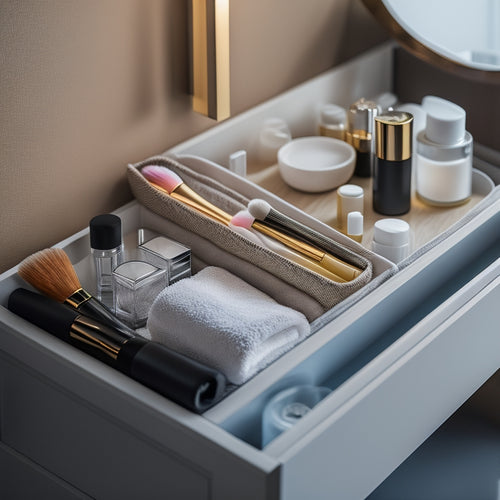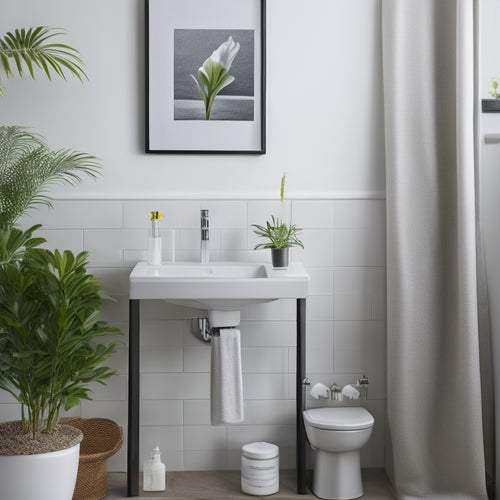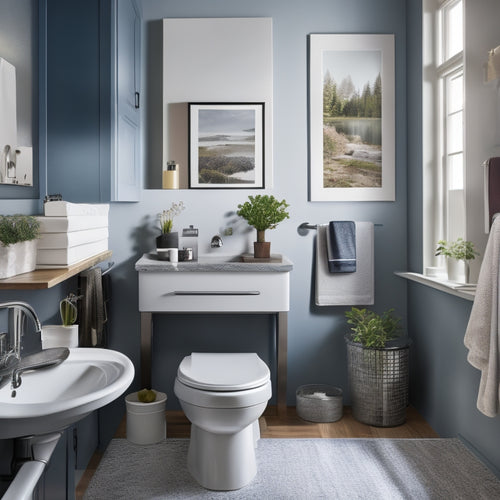
What to Know Before Buying a Bathroom Standing Tub
Share
When buying a bathroom standing tub, you'll want to contemplate several key factors to guarantee a safe, functional, and enjoyable bathing experience. Start by evaluating your bathroom space, taking precise measurements to determine the ideal tub size and placement. Research the various materials available, considering the pros and cons of acrylic, cast iron, and fiberglass options. Don't overlook vital safety features like slip-resistant surfaces and grab bars, as well as installation and maintenance costs. By understanding these essential elements, you'll be well-equipped to make an informed decision - and that's just the beginning of creating your perfect bathroom oasis.
Key Takeaways
- Assess your bathroom's spatial constraints and measure the room accurately to ensure a proper tub installation.
- Consider the benefits of standing tubs, including accessibility, relaxation, aesthetic appeal, and advanced features like hydrotherapy jets.
- Choose a tub material that balances durability, maintenance, and budget, with options including acrylic, cast iron, fiberglass, and stone resin.
- Ensure safety features like slip-resistant surfaces, grab bars, and emergency alert systems meet local building codes and regulations.
- Establish a budget considering initial costs, installation, maintenance, and advanced features, and prioritize comfort and accessibility options.
Understanding Standing Tub Benefits
When it comes to bathroom renovation, opting for a standing tub can be a transformative improvement, especially for those seeking a more accessible and comfortable bathing experience.
You'll appreciate the ease of getting in and out of the tub, which is particularly beneficial for individuals with mobility issues. Furthermore, standing tubs can be a breakthrough for those who value relaxation benefits. Imagine being able to soak in warm water up to your neck, surrounded by calming colors and soft lighting – it's the epitome of relaxation!
From an aesthetic appeal viewpoint, standing tubs can enhance the overall look and feel of your bathroom. Their sleek designs and modern finishes can create a spa-like ambiance, perfect for unwinding after a long day.
Additionally, standing tubs often come with advanced features like hydrotherapy jets, chromotherapy, and heated seats, which can further improve your bathing experience. By choosing a standing tub, you'll not only improve your bathroom's functionality but also create a tranquil oasis that promotes relaxation and rejuvenation.
Measuring Your Bathroom Space
You'll need to assess your bathroom's spatial constraints to guarantee a comfortable and functional standing tub installation.
To do this, measure the room's dimensions, factoring in any existing fixtures, doorways, and windows that may impact the tub's placement.
Space Requirements Matter
Most bathrooms have limited space, and every inch counts when it comes to installing a standing tub. You'll need to measure your bathroom space carefully to guarantee a comfortable and functional fit. Reflect on the design aesthetics you want to achieve and measure the space where the tub will sit, taking note of any obstructions like windows, doors, or plumbing fixtures.
When measuring, think about the tub's dimensions, including its length, width, and height. Don't forget to account for the space needed for plumbing considerations, such as pipes and valves.
You'll also want to reflect on the distance between the tub and any nearby fixtures, like the toilet or sink.
To get an accurate measurement, use a tape measure to record the length and width of the space. Take note of any irregularities, like alcoves or cutouts, that may affect the tub's fit.
Measuring for Clearance
Measuring for clearance is an essential step in guaranteeing a successful standing tub installation. You can't just eyeball the space and hope for the best – not if you want to avoid costly reconfigurations or, worse, a tub that doesn't fit.
Take out your trusty tape measure and get to work. Start by recording the dimensions of your bathroom, including any obstructions like plumbing fixtures or electrical outlets. Then, measure the doorway and any hallways leading to the bathroom to confirm your tub will fit through them.
When it comes to tub sizing, clearance guidelines are vital. Consider the tub's height, width, and length, as well as any features like faucets or handles that may protrude.
You'll also want to leave enough space around the tub for comfortable entry and exit. A good rule of thumb is to maintain at least 15 inches of clearance around the tub on all sides.
Tub Placement Options
When planning your standing tub installation, it's essential to reflect on the layout of your bathroom to determine the best placement options. You'll want to evaluate the tub aesthetics, guaranteeing it complements the existing fixtures and overall style.
Think about the focal points in your bathroom - do you want the tub to be the centerpiece, or blend into the background?
Next, examine the plumbing considerations. You'll need to verify the tub is installed near a water supply line, and that the floor can support the weight of the tub and water.
Take note of any obstructions, such as HVAC vents or electrical outlets, that might impact your placement options.
Measure your bathroom space carefully, factoring in the dimensions of the tub and any surrounding fixtures, like toilets or vanities.
Contemplate a corner installation to maximize floor space, or a freestanding tub for a more dramatic look.
With careful planning, you can create a beautiful and functional bathroom that meets your needs and showcases your personal style.
Types of Standing Tub Materials
You'll encounter a range of materials when shopping for a standing tub, each with its unique characteristics, benefits, and drawbacks. As you weigh your options, consider the following:
-
Acrylic tubs: Lightweight, easy to clean, and budget-friendly, acrylic tubs are a popular choice. However, they may scratch or crack over time.
-
Cast iron tubs: These heavy-duty tubs are durable and resistant to scratches, but they're also heavy, expensive, and may require additional support.
-
Fiberglass options: Fiberglass tubs are a cost-effective, lightweight alternative to acrylic tubs. They're also easy to clean, but may not be as durable.
When making your decision, think about your priorities: do you want a low-maintenance tub, or are you willing to invest in a more durable option?
Additionally, consider the aesthetic you're going for – do you prefer the sleek look of acrylic, the classic vibe of cast iron, or the versatility of fiberglass?
With stone resin, wood finishes, and metal designs also in the mix, you'll want to carefully weigh your options to find the perfect fit for your bathroom oasis.
Safety Features to Consider
When selecting a standing tub, you'll want to take into account safety features that can help prevent accidents and guarantee your independence.
You should look for tubs with slip-resistant floor surfaces to reduce the risk of falls, as well as grab bars and handrails that provide additional support and stability.
Additionally, you may want to take into account tubs with emergency alert systems that can quickly summon assistance in case of an emergency.
Slip-Resistant Floor Surfaces
As you contemplate the safety features of your bathroom standing tub, it's essential to prioritize slip-resistant floor surfaces to prevent accidents.
A bathroom can be a hazardous place, especially when water and soap are involved. You don't want to risk slipping and falling, especially when getting in or out of the tub.
To guarantee slip resistance, you'll want to choose flooring options that provide traction. Here are a few options to reflect on:
- Textured ceramic or porcelain tiles with a matte finish
- Natural stone flooring, such as travertine or slate, with a honed finish
- Slip-resistant vinyl or rubber flooring, specifically designed for bathrooms
Grab Bars and Handrails
In addition to slip-resistant floor surfaces, incorporating grab bars and handrails into your bathroom standing tub design is an essential safety consideration.
You'll want to confirm that you can safely enter and exit the tub, especially if you plan to age in place. There are various grab bar types to choose from, including fixed, folding, and wall-mounted options.
Consider installing them in strategic locations, such as near the tub's entrance, on the sides, or near the showerhead. Handrail installation should also be carefully planned, considering the user's height and reach.
Look for handrails with a non-slip surface and a sturdy construction that can support a significant amount of weight. Remember to follow local building codes and regulations when installing grab bars and handrails.
Emergency Alert Systems
Your bathroom standing tub's safety features shouldn't stop at grab bars and handrails.
You should also consider emergency alert systems to guarantee your safety while bathing. These systems are designed to provide an immediate emergency response in case of a fall or other accident.
-
Personal emergency response systems: These wearable devices allow you to call for help with the press of a button. They're especially useful if you live alone or have a medical condition.
-
SOS buttons: Installed in the tub or nearby, these buttons can be pressed to alert caregivers or emergency services in the event of an emergency.
-
Voice-controlled systems: Some bathroom standing tubs come equipped with voice-controlled systems that allow you to call for help or communicate with caregivers using voice commands.
When shopping for an emergency alert system, look for features like waterproof designs, easy installation, and compatibility with your existing bathroom setup.
Don't underestimate the importance of these safety features – they can be a lifesaver in case of an emergency.
Installation and Maintenance Costs
Beyond the initial purchase price, the cost of owning a bathroom standing tub extends to installation and maintenance, which can add up quickly if not carefully considered.
You'll need to factor in the cost of hiring a professional to install your tub, which can range from $1,000 to $3,000 depending on the complexity of the job. Be sure to research installation techniques beforehand to guarantee you're getting the best deal.
When it comes to maintenance, you'll want to stay on top of regular cleaning and inspections to prevent costly repairs down the line.
Look for tubs with features like self-cleaning jets or antimicrobial coatings to make maintenance a breeze.
Additionally, consider investing in a tub with a durable, easy-to-clean finish to reduce the risk of scratches and stains.
Comfort and Accessibility Options
You've invested in a bathroom standing tub, and now it's time to think about the comfort and accessibility features that will make it a true oasis.
When it comes to comfort, an ergonomic design is key. Look for a tub with a contoured seat and backrest that cradles your body, providing ideal support and relaxation.
In terms of accessibility, user-friendly features are a must. Consider the following:
- Handrails or grab bars for easy entry and exit
- A non-slip floor or textured surface to prevent slipping
- A seat height that's low enough for comfortable seating, but high enough to reduce strain on your back and legs
These features will guarantee that your standing tub isn't only comfortable but also safe and accessible for years to come.
Budgeting for Your Standing Tub
Set a realistic budget before making a purchase, as the cost of a bathroom standing tub can vary widely depending on factors such as size, material, and features.
You'll want to take into account not only the initial cost of the tub but also the cost of installation, maintenance, and any additional features you may want.
When determining your budget, think about your style preferences and the overall aesthetic you want to achieve in your bathroom. Do you want a sleek, modern look or a more traditional, ornate design?
The material and features you choose will greatly impact the final cost. For example, a tub with advanced hydrotherapy features or a unique shape may be more expensive than a standard, rectangular tub.
Additionally, the type of material used, such as acrylic, fiberglass, or solid surface, will also affect the price.
Frequently Asked Questions
Can I Install a Standing Tub Myself or Do I Need a Professional?
You're wondering if you can install a standing tub solo, but be warned: it's a challenging task. Consider DIY considerations like heavy lifting and complex plumbing, or you might face installation challenges that'll leave you drained - literally!
Are Standing Tubs Suitable for People With Mobility or Balance Issues?
You're wondering if standing tubs are suitable for you or a loved one with mobility or balance issues? Look for design considerations that incorporate mobility aids, like grab bars and non-slip mats, to guarantee a safe and comfortable bathing experience.
Can I Use a Standing Tub With a Shower Curtain or Door?
You're wondering if you can use a standing tub with a shower curtain or door - the answer is yes! You'll want to investigate shower curtain options with magnets or suction cups for a watertight seal, and consider door installation tips like waterproofing and proper drainage.
How Do I Clean the Area Around the Standing Tub Faucet?
Okay, you're past the 'I'm-not-a-pro-at-this' fear, so here's the deal: to clean around the standing tub faucet, you'll need gentle cleaning supplies and some slick maintenance tips - think microfiber cloths, vinegar, and a toothbrush for those pesky crevices.
Are Standing Tubs Compatible With Heated Floor Systems?
When considering a standing tub, you'll find most models are compatible with heated floor systems, but it's essential to check the tub's drainage options and materials, like acrylic or stone resin, to guarantee a harmonious and toasty union.
Conclusion
As you prepare to take the plunge and invest in a bathroom standing tub, remember that patience is a virtue. Don't rush into a decision without considering the benefits, space constraints, materials, safety features, installation costs, comfort options, and budget. By doing your due diligence, you'll end up with a tub that's customized to your needs, providing a relaxing oasis that'll make all your hard work worth it.
Related Posts
-

Modern Bathroom Drawer Organizers With Dividers
Modern bathroom drawer organizers with dividers help you make the most of your space and keep your essentials tidy. T...
-

Top-Selling Bathroom Organization Ebook - Only $0.99
This top-selling bathroom organization eBook, available for instant purchase at an unbeatable price of $0.99, provide...
-

Bathroom Planner Workbook Review: A Home Project Manager
The Bathroom Planner Workbook is a game-changer for homeowners seeking a stress-free bathroom remodel. This all-encom...


